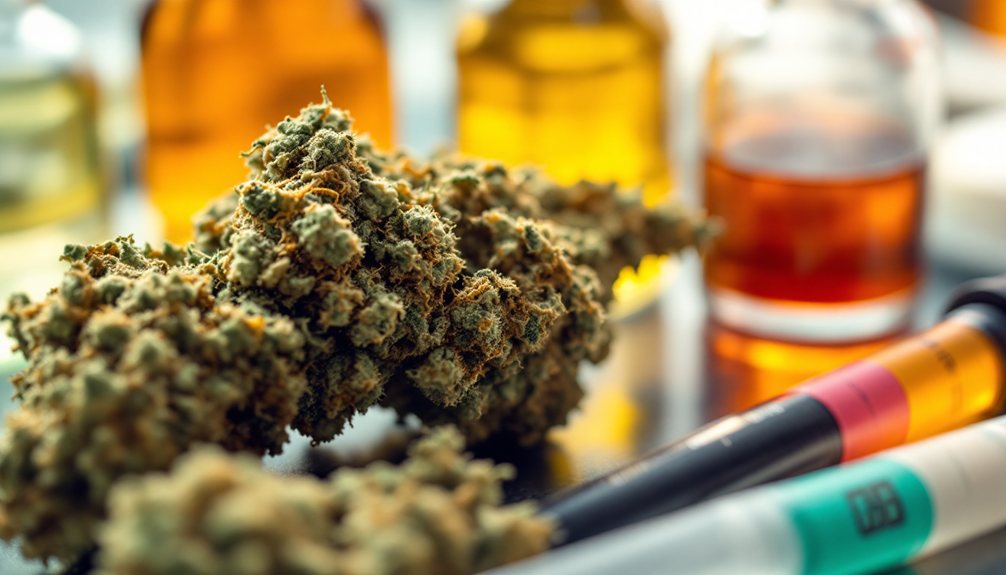To find your perfect cannabis dose, start with low THC products (under 10%) and minimal amounts – one small puff for smoking/vaping or 2.5mg for edibles. Wait at least two hours before taking more, as your individual tolerance depends on factors like metabolism, frequency of use, and consumption method. Track your experiences in a dosing journal, noting effects and timing. Understanding these fundamentals will help you develop a personalized dosing strategy that works best for you.
Expert Highlights
- Start with minimal doses (2.5mg THC or one small puff) and wait at least two hours before increasing consumption.
- Choose appropriate consumption methods based on desired onset time: smoking (minutes), vaping (1-3 minutes), or edibles (30-90 minutes).
- Track dosage, effects, and timing in a detailed journal to identify patterns and make informed adjustments.
- Consider THC:CBD ratios for desired effects – 1:1 for balance, 2:1 for moderate psychoactive effects, 1:20 for minimal intoxication.
- Monitor tolerance levels and take periodic breaks (2-7 days) to maintain effectiveness and prevent overconsumption.
Understanding Cannabis Potency and THC/CBD Ratios

When choosing cannabis products, you’ll need to understand two key measurements: THC and CBD percentages. THC creates psychoactive effects, while CBD offers therapeutic benefits without intoxication. These percentages indicate potency – higher numbers mean stronger effects.
Common THC:CBD ratios include 1:1 for balanced effects, 2:1 for moderate psychoactive impact with therapeutic benefits, and 1:20 for minimal intoxication with maximum therapeutic potential.
For beginners, start with products containing less than 10% THC and equal or higher CBD content. Remember that individual tolerance varies, so these ratios serve as general guidelines for responsible consumption.
Start Low and Go Slow: The Golden Rule of Dosing

Now that you understand potency and ratios, let’s focus on the most important principle of cannabis consumption: starting low and going slow.
Begin with the smallest possible dose and wait at least two hours before consuming more. This allows you to gauge your body’s response and avoid overwhelming experiences.
For edibles, start with 2.5mg THC or less. For smoking or vaping, take one small puff and wait 15 minutes.
Everyone’s endocannabinoid system responds differently to cannabis. By practicing patience and careful observation, you’ll discover your ideal dose while maintaining a safe, enjoyable experience for yourself and those you serve.
Our knowledgeable team members can provide personalized dosing recommendations based on your specific needs for relaxation, relief, or recreation.
Factors That Influence Your Cannabis Tolerance

Your unique body chemistry plays a fundamental role in how you’ll respond to cannabis, with factors like metabolism and brain chemistry affecting your experience.
If you’re new to cannabis, you’ll likely feel stronger effects than someone with prior experience, as your body hasn’t built up a tolerance to cannabinoids.
How often you use cannabis directly impacts your tolerance level – frequent use typically leads to needing higher doses to achieve the same effects.
Individual Body Chemistry
Because each person’s body chemistry is unique, cannabis affects everyone differently. Your metabolism, hormones, and endocannabinoid system all play vital roles in how you process THC and CBD.
| Body Factor | Impact on Cannabis Effects |
|---|---|
| Metabolism | Fast metabolizers process cannabis quickly |
| Hormones | Estrogen/testosterone levels affect sensitivity |
| Body Fat | THC stores in fat cells, influencing duration |
| Age | Seniors often need lower doses |
Your liver enzymes, specifically CYP2C9, determine how quickly you break down cannabinoids. Some people naturally produce more anandamide, an endocannabinoid that affects your tolerance and response to cannabis.
Prior Cannabis Experience
Beyond individual body chemistry, prior cannabis experience plays a major role in determining appropriate dosing.
If you’re new to cannabis, you’ll likely find that small amounts produce noticeable effects. Your tolerance remains low until you begin regular consumption.
Experienced users typically require higher doses to achieve desired effects. Your body has developed familiarity with cannabinoids through repeated exposure, leading to reduced sensitivity.
Taking a tolerance break can help reset your system.
Consider your experience level when choosing products and doses. Start low if you’re a beginner, and adjust gradually if you’re returning after a break.
Frequency of Use
Regular cannabis consumption directly impacts how quickly tolerance develops.
If you’re using cannabis multiple times per day, you’ll likely need higher doses to achieve desired effects compared to occasional users. Your body builds tolerance to THC within days of consistent use.
Daily users often find they need to increase their dose every few weeks to maintain effectiveness.
If you’re serving medical patients, recommend they take regular tolerance breaks – typically 2-7 days without cannabis – to reset their system.
Weekend-only users generally maintain lower tolerance levels and require smaller doses.
Different Consumption Methods and Their Impact on Dosing
When you’re choosing how to consume cannabis, you’ll notice dramatic differences in onset time and effects between smoking, which hits almost immediately, and edibles that can take 1-2 hours to peak.
Vaping offers a middle ground, with effects typically felt within minutes but lasting shorter than smoking, while tinctures give you precise control through measured droppers.
You’ll need to adjust your dosage markedly based on your method – a 5mg edible can feel as strong as 20mg when smoked, making it essential to start low and increase slowly with any new consumption method.
Smoking Vs Edible Effects
Understanding how cannabis affects your body depends heavily on your chosen consumption method.
When you smoke cannabis, you’ll feel effects within minutes, peaking around 30 minutes and lasting 2-3 hours. The effects are immediate but less intense than edibles.
Edibles take 30-90 minutes to kick in since they must be digested first. The effects can last 4-8 hours and are often more potent because THC converts to 11-hydroxy-THC in your liver.
This metabolic process creates stronger, longer-lasting effects. You’ll need considerably lower doses with edibles compared to smoking to achieve similar results.
Vaping Absorption Time Differences
Vaporizing cannabis offers a unique absorption profile that falls between smoking and edibles. When you vape, cannabinoids enter your bloodstream through your lungs within 1-3 minutes, providing effects that typically last 2-3 hours. The onset is slightly slower than smoking but considerably faster than edibles.
You’ll notice that vaping delivers a cleaner experience with more precise temperature control. This allows you to target specific cannabinoids and terpenes, helping you customize your dose.
The vapor’s bioavailability ranges from 30-60%, meaning your body absorbs more compounds compared to smoking’s 20-30% rate, making it easier to gauge your ideal dose.
Tincture Dosage Control Methods
Tinctures provide exceptional control over cannabis dosing through their measured dropper systems.
You’ll find most droppers marked with 0.25ml increments, letting you precisely adjust your dose. Start with 0.25ml and wait 30-45 minutes to assess effects before increasing.
To guarantee accurate dosing, hold the dropper vertically and squeeze the bulb completely. Place drops under your tongue for fastest absorption, or add them to beverages.
Keep track of your ideal dose in a journal, noting both the amount and timing of effects.
Store your tincture in a cool, dark place to maintain potency and consistency in dosing.
Micro-Dosing Techniques for Optimal Results
How can smaller amounts of cannabis provide meaningful benefits?
Micro-dosing allows you to maintain clarity while experiencing subtle therapeutic effects. Start with 2.5mg THC and gradually adjust based on your body’s response.
Time your doses strategically throughout the day – morning for focus, afternoon for creativity, or evening for relaxation. Track your experiences in a journal to identify ideal timing and dosage patterns.
Keep your micro-doses consistent by using precise measurement tools like calibrated droppers or pre-measured edibles.
You’ll achieve better results by spacing doses at least four hours apart and staying mindful of your tolerance levels.
Managing Side Effects Through Proper Dosing
Although cannabis can provide numerous benefits, improper dosing may lead to unwanted side effects like anxiety or drowsiness.
To help you manage potential side effects and find your ideal dose, follow these key strategies:
- Start with the lowest possible dose and wait at least 2 hours before increasing. This allows you to gauge your body’s response and avoid overconsumption.
- Keep a dosing journal to track your experiences, noting both positive effects and any unwanted reactions.
- If you experience anxiety or discomfort, try products with higher CBD content and lower THC levels, as CBD can help counteract THC’s side effects.
Tracking Your Cannabis Experience and Adjusting Doses
To make the most of your cannabis therapy, maintaining detailed records of each session is essential. Track key details like dosage, consumption method, timing, and effects in a journal or app. This data helps you identify patterns and optimize your experience.
| Track This | Why It Matters |
|---|---|
| Strain Type | Different strains produce unique effects |
| Time of Day | Your body responds differently at various times |
| Environment | Setting impacts your experience |
Review your notes regularly to spot what works best for you. When adjusting doses, make small incremental changes and wait several days between adjustments to accurately gauge effects.
Medical Cannabis Dosing Considerations
Medical cannabis dosing requires an individualized approach based on your specific health conditions, symptoms, and treatment goals. When working with your healthcare provider, you’ll develop a personalized dosing strategy that considers your medical history and current medications.
- Start with micro-doses (1-2.5mg THC) and gradually increase until you find symptom relief, especially if you’re new to cannabis or treating chronic conditions.
- Monitor your body’s response closely, including any side effects, and document your experiences for your healthcare provider.
- Consider the timing of doses around your daily activities, as certain conditions may require different dosing schedules throughout the day.
Building a Sustainable Long-Term Dosing Strategy
Once you’ve established your initial dosing approach with your healthcare provider, developing a sustainable long-term strategy becomes the next key focus. Track your response patterns, adjust gradually, and maintain open communication about your progress. Consider your lifestyle, daily routines, and therapeutic goals.
| Time Frame | Action Steps | Monitoring Points |
|---|---|---|
| Daily | Log doses & effects | Symptom changes |
| Weekly | Review patterns | Side effects |
| Monthly | Assess progress | Tolerance levels |
| Quarterly | Consult provider | Treatment goals |
Remember to document any changes in your condition, medication interactions, or lifestyle factors that might affect your treatment’s effectiveness.
Frequently Asked Questions
How Long Should I Wait Between Doses When Mixing Different Cannabis Products?
You’ll want to wait at least 2-3 hours between different cannabis products to understand each one’s effects and avoid potential interactions or overwhelming your system.
Can I Take Cannabis While on Prescription Antidepressants?
You’ll need to consult your doctor before combining cannabis with antidepressants, as interactions can be dangerous. Don’t make changes to your medication routine without professional medical guidance.
What’s the Best Time of Day to Consume Cannabis for Sleep?
You’ll want to consume cannabis 1-2 hours before bedtime. This lets the effects peak as you’re ready for sleep while giving you time to complete your nighttime routine.
Does Eating Certain Foods Enhance or Diminish Cannabis Effects?
You’ll notice stronger effects when consuming cannabis with fatty foods like nuts or avocados. Mango can intensify the experience due to myrcene content, while citrus fruits may reduce THC’s impact.
How Do Caffeine and Alcohol Interact With Cannabis Consumption?
When you combine cannabis with alcohol, you’ll intensify both substances’ effects. Caffeine can counteract cannabis-induced drowsiness but may increase anxiety and heart rate for some people.
Expert Final Thoughts
Finding your ideal cannabis dose takes time and careful attention to your body’s responses. You’ll need to take into account multiple factors like consumption method, potency, and your personal tolerance levels. Remember to track your experiences, start with minimal amounts, and adjust gradually. Whether you’re using cannabis medicinally or recreationally, maintaining a consistent, thoughtful approach to dosing will help you achieve optimal outcomes safely and effectively.





Join the Discussion